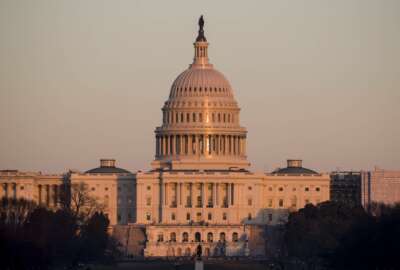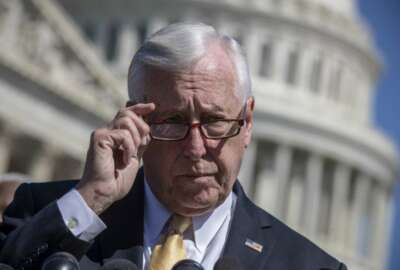
Agencies, AFGE begin preparations for another government shutdown
As agencies plan for the possibility of another government shutdown at the end of this week, the American Federation of Government Employees is telling its memb...
Best listening experience is on Chrome, Firefox or Safari. Subscribe to Federal Drive’s daily audio interviews on Apple Podcasts or PodcastOne.
With less than a week now until the latest funding deadline expires this Friday, agencies are officially preparing for another government shutdown.
Guidance from the Office of Management and Budget instructs senior agency officials to begin preparations one week before the possibility of a lapse in appropriations.
The American Federation of Government Employees is also preparing for the possibility.

“We informed our members that a shutdown is possible,” AFGE National President J. David Cox told reporters Monday during the union’s legislative conference in Washington. “[They] should do everything they can to conserve their resources, let’s be real. We wouldn’t be good leaders of our union not to do that. But by the same taken, if your take home pay is about $500 a week there’s not a lot of conserving of resources that you’re able to do.”
For some, conserving financial resources may be difficult, as many federal employees are still waiting for full retroactive payments after the 35-day partial government shutdown. Payroll providers are still making adjustments to make employees whole.
Some 1,000 employees at the Census Bureau’s National Processing Center in Jeffersonville, Indiana, didn’t receive back pay until this past Friday, Cox said.
“Census tells us what happened with them [was] they loaded several payrolls in at one time and their own system just crashed, and they couldn’t pay everybody properly,” he said.
If either a temporary or long-term funding solution isn’t apparent by Wednesday, Cox said AFGE will be ready to organize. The union, along with several others, held rallies across the country to protest the government shutdown. It also held a silent protest in the Hart Senate office building in the final week of the 35-day lapse.
“We will be ready,” Cox said. “We will ready Wednesday. If we don’t have something definite this Wednesday, we will be in the Hart building this Wednesday. We will be ready to roll all over this country.”
AFGE is working with members of Congress to find other ways to alleviate the financial impacts of a possible government shutdown. Lawmakers are discussing whether legislation could waive fees for federal employees who missed payments during the government shutdown and may see their credit scores dip, for example.
The Federal Employee Education and Assistance Fund (FEEA), which provided small grants to employees in especially tough financial circumstances during the lapse, said it worked with more than 3,000 federal families during the last government shutdown. The fund saw more than 100,000 hits to its website in January, a significant spike compared to the 15,000 hits FEEA usually gets per month.
FEEA will reopen its micro-grant program if the government does shut down again and federal employees miss another paycheck, said Robyn Kehoe, the fund’s deputy director.
But even as acting White House Chief of Staff Mick Mulvaney said the possibility of a government shutdown is possible at the end of the week, the prospect is off the table for at least one Republican senator.
“Never again should we put our government employees in this situation,” Sen. Lisa Murkowski (R-Alaska) told AFGE members Monday. “Never, never again. I don’t want it for 35 days, and I don’t want it for one day. We have a little bit of decision coming up here on Friday. My job right now as I leave you is to go back over to the Hill and start rattling cages. It needs to be made clear that if we can’t figure that out, if we can’t figure out how we reach a deal, we do not — we do not penalize our federal workers by withholding your paychecks.”
Murkowski on Monday also announced she’d co-sponsor legislation that would grant federal employees a 2.6 percent pay raise for the rest of 2019. The bill, which Sen. Chris Van Hollen (D-Md.) introduced in the Senate, has already passed the House.
Related Stories

As federal employees await back pay fixes, another government shutdown looms
If there’s one benefit of the last 35-day lapse, it’s that the American public has a better understanding now of what federal employees do — and the benefits of having a “fully staffed and funded” federal government, Cox said.
“Americans realized they need a fully functioning TSA, air traffic control system, FAA inspectors to keep aviation safe and secure,” he said. “Americans realize they need a fully staffed and funded HUD to keep seniors and the poor who depend on public housing from becoming homeless. Americans realize they need a fully-staffed and funded USDA.”
For freshman Rep. Donna Shalala (D-Fla.), her constituents have a better understanding of what federal employees do as well. Shalala served as secretary of the Department of Health and Human Services during the Clinton administration.
“When our colleagues don’t work it affects all of us,” she said. “One federal worker furloughed affects every federal worker and every American. That’s what we learned during the last shutdown, and I don’t want to learn that lesson ever again. The lesson is we respect the people who work and support our country. We pay them fairly, and we make certain that they have jobs in the future. The future of the country is directly tied to the quality of the federal workforce, and I think every American now understands that.”
Copyright © 2024 Federal News Network. All rights reserved. This website is not intended for users located within the European Economic Area.
Nicole Ogrysko is a reporter for Federal News Network focusing on the federal workforce and federal pay and benefits.
Follow @nogryskoWFED




